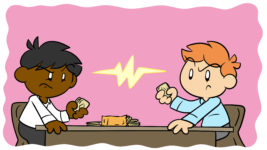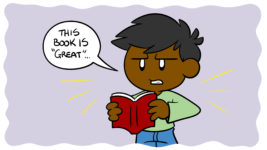While narratives that focus on action can come from many different genres – from spy fiction to high fantasy – they are all also part of a single stylistic school. That is to say that no matter what type of action-orientated story you’re telling, you can benefit from approaching ‘action’ stories as a single genre.
While I’ve already written about action scenes, in this article, I intend to take a wider view of what works in stories that depend on action. After all, not every moment can be full of action – the readers (and probably even the characters) would get tired. That said, one of the best pieces of advice for an action scene is also great advice for an action narrative as a whole.
The barer the better
It’s a nigh-immutable law that good action thrives on brevity. Action scenes should be short, both in the length of the scene and in the way it’s written – single clauses and even a basic vocabulary help to communicate the immediacy and pace of a situation.
That doesn’t mean, however, that when the action itself stops the style can afford to become flabby. The first reason for this is simply that readers will notice the difference. If there’s a major change in style when the action starts then that action will be compartmentalized in the reader’s brain. The story will be split between the safe, regular parts and the exciting, action parts.
The second reason to try and maintain a curt style throughout an action narrative is to imbue your setting, rather than individual scenes, with the impetus of action.
Richard Stark’s ‘Parker’ novels are some of the most curtly written stories on the market. The stories detail the adventures of a brutal, near-emotionless bank robber and the unfortunate people who get in his way.
In The Outfit, Parker is trying to show an organized crime syndicate that going against him will be a costly affair. To this end, he contacts as many of his bank robber colleagues as he can, telling them they have carte blanche to go after syndicate operations. What follows is chapters of heist after action-packed heist.
Each chapter features characters, locations, and events which the reader is encountering for the first time, and which they know they will likely never see again. The knowledge that the jobs will influence the Parker/syndicate struggle is not enough, alone, to make these chapters interesting. Despite this, the chapters and the book as a whole are thrilling, so how does Stark do it?
The accountant hurried to the safe. It was a big steel box, four feet high, three feet wide, three feet deep. He worked the combination hurriedly, but was so nervous he did it wrong the first time. He tried again, got it that time, and the safe opened.
While the mailman tied and gagged the accountant, the other two loaded the money from the safe into the briefcases. Then they went out into the hall where the trombone player packed the [machine guns] into the trombone cases and the shotguns away in the mailbag.
-Richard Stark, The Outfit
As evident in the extract above, Stark doesn’t give the reader any space to do anything but be in the moment. Actions are described curtly – function is front and center, since it is the action on which the reader is being asked to focus. The same is true of scenes intended to characterize or tell the non-action of the story.
There was no-one he recognized in the lobby. He left the note for Bert at the desk and went up to his room. It was empty. As far as he could tell, no-one had been in it. He packed his suitcase, stuffing the six wallets into it, with the identity cards and driver’s licenses, but without the seventeen hundred dollars they’d once contained, and went downstairs to check out.
This clipped style creates a consistent world, and one in which action could happen at any time. The more you divorce the style of your action from the rest of the story, the less believable and relevant that action will feel.
Having separate ‘talking scenes’, ‘description scenes’ and ‘action scenes’ leaves you with huge gaps in style that readers don’t expect and won’t enjoy. Infusing the stylistic traits of action into every scene means that every scene lives up to the promise that first attracted your reader.
Style is only half of what you’ll need to create this impression, though. The other half is a constant sense of consequence.
Consequence is key
Action scenes matter because they deal with a known resource. In fight scenes this resource is the well-being of a character, and their subsequent ability to achieve their objectives. As two characters fight, all sense of excitement and tension comes from the possible consequences. The protagonist may be hurt, or die, or be stopped from something they must do.
While this is a key facet of writing action scenes, it’s also important to writing a wider narrative. The reader needs to appreciate how every event, whether action or speech or just new information, impacts on the resources that matter.
This is why so many spy stories start with a briefing; the better the reader’s understanding of the goals and stakes of the story, the more invested they will become.
Since action stories need to keep some of their tension and excitement going beyond specific action scenes, this means approaching the narrative with a constant appreciation for the story’s key resources. When a new character is introduced their relevance to the resources must be front-and-centre – what will it cost if this person is a traitor, how do they stand to hurt the protagonist?
While this is the case in many genres, it stands out in action writing because implication is a lot less effective. When fights scenes are written, writers focus on explicit physical information to highlight threat – the antagonist swipes a knife at the protagonist’s throat, and the reader understands this would be immediately deadly. In the same way, non-action decisions have to be presented with an explicit understanding of how they affect the protagonist’s ability to reach their goal.
In Richard Stark’s The Man with the Getaway Face, Parker sets up a robbery with some other characters. One is bullish, insisting on her own plan with the intention of double-crossing Parker later on. Parker himself informs the reader about the risk this poses to him attaining his goal.
“So one of you rides with me,” she said. “Skimm. He can ride with me. All right?”
It was bad. The whole idea was stupid. It was sloppy, it was bad business.
But Parker nodded. “That’s all right. Just so one of us goes along with the money.”
If he let her keep her original plan he could be sure of getting the money back. If he forced her to change by making the grab more sensible, then maybe he wouldn’t be able to figure out her cross in time. He’d had to argue so she wouldn’t get suspicious.
– Richard Stark, The Man with the Getaway Face
The reader instantly understands the relevance of every decision in this scene – stylistically, they experience it as action.
Of course focusing on the wider goals of a story can have its price, and it can be harder to set the scene and build characters when you’re also making a concerted effort to be as minimalist as possible.
What, then, can an action writer do to remedy these issues?
Implement a philosophy
Since almost every person has a philosophy regarding the human condition, most stories have them as well. ‘People are basically good’ is an example, as is ‘given a hard enough situation, everyone reverts to self-interest’. For action writers in particular, this core philosophy is key to narrative success.
In Suzanne Collins’ The Hunger Games the core philosophy is ‘war destroys innocence’. Most of the book, in fact most of the trilogy, is spent with characters who have been damaged by some form of combat. Haymitch Abernathy has become an addict, Finnick Odair pines for a lost love, and even the protagonist Katniss Everdeen becomes more and more separated from her emotions and humanity.
Here characters are explored in terms of their damage, both their own particular brand of suffering and the ways in which they combat it. Peeta Mellark is seen as inherently good because he takes a long time to submit to the psychological pressure of conflict, and even then his injury is presented as an offshoot of his love for Katniss. Similarly Haymitch’s bravery and compassion are shown through his ability to (somewhat) overcome his own form of damage enough to give good guidance to Katniss and Peeta.
While it doesn’t address every aspect of a character, this idea of a central philosophy ties a great deal of who a character is to the events of the story, and cuts down on the tangents necessary to explore them as individuals. When the reader can be made to understand an idea about the human condition as a ‘rule’ in the story, then character-work can be done chiefly through how characters engage with this rule.
In The Outfit Stark proffers ‘humans are base’ as a philosophical truth. Thus, though the protagonist Parker is neither moral or likable, his understanding of his own desires endears him to the reader. Parker knows he is base, he knows he exists in a base world, and the reader sees this knowledge as worldliness. Parker’s bad points are still bad points, but the reader understands him as he relates to the philosophy – if everyone is base then his own baseness is less offensive, and he is at least smart enough to recognize it and honest enough not to pretend to be anything else.
When chatty, friendly characters arrive the reader sees them as false. When a spurned woman instigates an attack on Parker, the reader does not see her as evil, or even immoral, but small – her own base desires exist within the arena of her home and social life, whereas Parker’s are more ambitious.
Writers control how readers encounter their world, and so the key to a core philosophy is in redefining what readers should admire and dislike in characters, and in binding all characters to one or two shared standards.
Parker would be seen as cruel in another story, but since he inhabits a world in which kindness is not expected, he comes across as merely dispassionate. Similarly, Katniss’ tendency to approach events in terms of what they mean for her could be damning in another narrative, but in her own story it is just the manifestation of her damage – it is a personal failing, but a minor one in a world where characters are expected to fail.
In this way, action writers can have characters define themselves against a skewed set of values, influencing how they are seen by the reader while still cleaving to a minimalist style of writing. No-one needs to wax philosophical when the reader understands the story’s philosophy, and is already judging the characters against it.
Taking action
The key to writing a great action story is all about effective communication. First you have to understand the central goal of your story, then you have to focus on how the events, dialogue and actions in your story affect that goal, then you have to communicate this relationship clearly and often to your readers. Follow this formula closely and you’ll be writing white-knuckle stories in no time.
For more on writing great action check out Want the secrets of a great chase scene? or for more on what makes particular genres work try The 3 golden rules of writing a young adult novel.
Do you love writing action, or do you prefer to hash things out through dialogue? Let me know in the comments.





